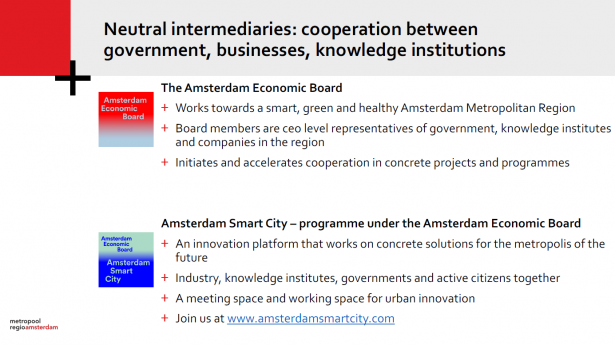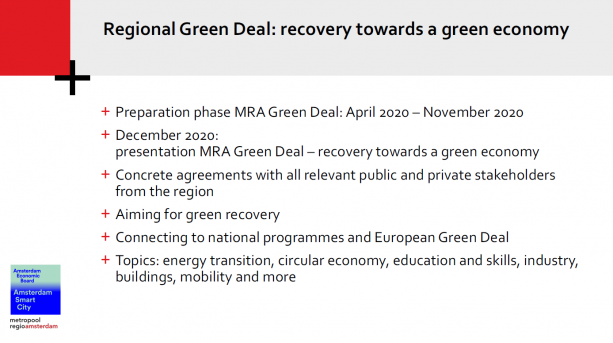Stay in the know on all smart updates of your favorite topics.
To keep Amsterdam liveable the municipality collaborates with its citizens. On average Amsterdam’s population grows with 10.000 people a year. This small big city has a density of 5065 people per square km, over 180 different nationalities. 19% of the total Dutch GDP is earned in the Amsterdam Metropolitan Area. Between 2015 and 2016, the amount of tourists in Amsterdam increased by 7%. To keep Amsterdam’s 162 canals, monumental centre and residential areas liveable, innovative initiatives are required. Share your innovative concepts and ideas here!
Aandacht voor klimaatverandering in het onderwijs
In gesprek met docent-onderzoeker Lisette Klok (HvA) over klimaat in het onderwijs
Hoe wordt er binnen het onderwijs aandacht besteed aan klimaatverandering? Docent-onderzoeker Lisette Klok (HvA minor Klimaatbestendige stad) spreekt over hoe de thematiek van klimaatverandering in hun opleiding terugkomt, wat de opleiding de studenten hierover wil meegeven en hoe zij zelf tegen deze thematiek aankijken. ‘Zij kennen de urgentie van het wereldwijde klimaatprobleem en weten dat we ons moeten aanpassen aan de klimaatverandering die gaande is.’
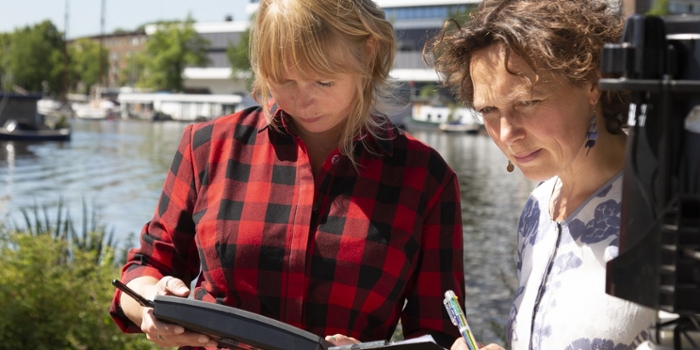
‘Bij de minor Klimaatbestendige stad van de Hogeschool van Amsterdam leren studenten alles over klimaatverandering, de gevolgen hiervan voor de stad en hoe stedelijk gebied klimaatbestendig ingericht kan worden. Klimaatverandering betekent meer extremen: heftiger regenval en meer hitte. Extreme buien leiden tot wateroverlast en waterschade. Hitte geeft gezondheidsproblemen en zet de leefbaarheid van steden onder druk. Ook droogte en zeespiegelstijging zijn thema’s binnen de minor. Om al deze nadelige gevolgen van klimaatverandering te voorkomen en prettig te kunnen blijven leven, moet de inrichting van het stedelijk gebied worden aangepast. De belangrijkste vraag binnen de minor is daarom: Hoe kunnen steden, wijken en straten klimaatbestendig worden ingericht rekening houdend met meer hitte, extreme regenval, droogte en overstromingen?
MINOR KLIMAATBESTENDIGE STAD
De studenten die voor deze minor kiezen doen dit, omdat zij weten dat er in de nabije toekomst veel werk verricht zal moeten worden om Nederland klimaatbestendig in te richten. Zij kennen de urgentie van het wereldwijde klimaatprobleem en weten dat we ons moeten aanpassen aan de klimaatverandering die gaande is.
MEETONDERZOEKEN IN DE EIGEN WOONOMGEVING
Naast theoretische kennis, gastcolleges en excursies, voeren studenten ook meetonderzoeken uit om temperaturen en neerslagpatronen in de eigen woonomgeving in kaart te brengen. Ook doen de studenten praktijkervaring op doordat zij een actueel klimaatbestendig project voor een echte opdrachtgever moeten uitvoeren. De meeste studenten vinden dit onderdeel van de minor het leukst. Gemeentes, waterschappen of adviesbureaus dienen vaak als opdrachtgever en de studenten oefenen in de rol van opdrachtnemer. Hierdoor proeven zij de sfeer die er in ‘de echte wereld’ hangt met de bijbehorende ‘officiële’ vergaderingen.
AAN DE SLAG MET UITEENLOPENDE VRAAGSTUKKEN
Ze werken daarbij aan veel verschillende vraagstukken: Wat zijn de meest urgente locaties om maatregelen te nemen met het oog op wateroverlast, droogte en hitte? Met welke inrichtingsmaatregelen kan een bepaalde wijk of straat klimaatbestendig ingericht worden? Hoe verhouden de baten van deze maatregelen zich met de kosten? Hoe zou een klimaatbestendig ontwerp voor een bepaalde buurt eruit kunnen zien? Hoeveel oppervlaktewater, waterberging, groen of groene daken zijn nodig om te voldoen aan de klimaatbestendige beleidsdoelen van een gemeente?
KLIMAATBESTENDIG ONTWERPEN
Het gewenste eindresultaat van zo’n praktijkopdracht is in de meeste gevallen een klimaatbestendig ontwerp van een gebied onderbouwd met een gedegen kwetsbaarheidsanalyse, kloppende argumentaties, juiste berekeningen en ondersteund door mooie visualisaties. Zo werken we in de minor samen met praktijkpartijen om verder te werken aan technische en ontwerp gerelateerde vraagstukken rondom klimaatverandering.’
STUDENTEN IN ACTIE:
Studenten zetten straten onder water
HvA-dak proeftuin voor 10.000m2 klimaatbestendige daken
Gezocht: verkoeling in Amsterdam
Studenten onderzoeken waterpasserende bestrating
Want a printed version of my free e-book Cities of the Future?
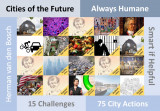
Recently, I published my new e-book: Cities of the Future. Always Humane. Smart if Helpful.
You can download this book for free here:
Dutch version
https://www.dropbox.com/s/ytdadwgdsdw6zke/Looking%20for%20the%20city%20of%20the%20future%20NL.pdf?dl=1
English version
https://www.dropbox.com/s/kfywoszhrn4xi5j/Looking%20for%20the%20city%20of%20the%20future.pdf?dl=1
In case you prefer a compact printed version in Dutch (180 pages), transfer €20,00 to IBAN NL35 INGB 000 167 55 50 on behalf of H. van den Bosch, mention your address and you will receive your copy in a few days
Look back! Event recap: 'De Mindset voor een Menselijke Slimme Stad'

Technology helping to make cities more sustainable and better is not a new concept. It is the idea behind the "Smart City" concept. But nobody wants to live in a Smart City that focuses only on technology. Of course, we want to live in a safe, green and vibrant city.
How do we create sustainable and liveable cities? How can technology be a useful tool in this? How do we put people at the center of these cities and take their values into account in the development?
On the 17th and 18th of November 2020 we held two events on this important topic, together with BTG and the City of Almere.
This video shows you the event of the 17th of November. Klaas van Egmond, professor of Geosciences, takes us through an inspiring story about various values and the mindset required to meet challenges in cities. After this talk, you will see a roadshow with three start-ups that realize better streets, neighborhoods and cities, using technology:
- Geofluxus - 'We map waste'
- Asset Hubble - 'Detecting cracks in masonry'
- Seenons - 'Waste collected easily, sustainably and separately'
As icing on the cake, we are launching the new online platform where you get daily inspiration and knowledge online.
In short, an event full of new insights, network and inspiration!
Check out the video of the event on Tuesday 17 November 2020:
11th Urban COVID-19 monitor
Every two weeks the City of Amsterdam publishes a monitor on urban measures to deal with COVID-19. Different issues are discussed, depending on the questions we receive from within the municipal organisation. It is aimed at giving a general overview of urban measures worldwide and of other information relevant for cities. It also has an overview of EU measures and of different relevant sources. Please find the newest version of the monitor attached.
Interessant Volkskrant-artikel over de groeiende beweging van citizen-sensing
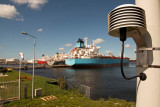
De provincie Noord-Holland is twee jaar geleden in samenwerking met het RIVM, de Waag Society, Tata Steel en lokale overheden het project Hollandse Luchten gestart om de luchtkwaliteit op zwaarder belaste locaties rondom het Noordzeekanaalgebied fijnmazig in kaart te brengen. Hierbij worden inwoners begeleid en opgeleid om de sensoren in elkaar te zetten en de uitkomsten van de metingen te begrijpen. Vervolgens kan er een discussie worden gehouden over het gezamenlijk ontstane beeld van de omgevingskwaliteit.
De Volkskrant schreef een artikel over hoe het meten van de omgevingskwaliteit door inwoners met de jaren is ontwikkeld en wat voor een invloed dit heeft op de discussie rondom leefbaarheid van gebieden.
Lees en volg de themareeks Bodem & Ondergrond van Rooilijn

Een artikelenreeks over de positie van bodem en ondergrond in ruimtelijke ontwikkeling door Rooilijn, online open-access tijdschrift voor wetenschap en beleid in de Ruimtelijke ordening. Met artikelen van onder andere Geert Roovers, Maarten Hogeweij, Melika Levelt, Astrid Druijff, Marco Scheffers, Joeri Naus en Erwin Biersteker
De ondergrond levert een essentiële bijdrage aan alles wat boven de grond wordt gepland en gebouwd. Naast grondstoffen om te bouwen gebruiken we de ondergrondse lagen ook om gebouwen te funderen, rioleringen en leidingen aan te leggen, ons van energie en drinkwater te voorzien en om water te bergen. Gek dus eigenlijk dat de ondergrond lang weinig aandacht heeft gehad in de ruimtelijke planning. Daarom nu extra aandacht voor bodem en ondergrond in Rooilijn.
‘Niemand wil in een Smart City wonen’

Met de lancering van de Corona app is digitalisering van de publieke ruimte gesprek van de dag. Als stad en als regio staan we voor grote opgaven. De coronacrisis momenteel voorop, maar ook de energietransitie, de beweging naar een circulaire economie en naar schone mobiliteit zijn nog steeds zeer urgent.
Opgaven die stuk voor stuk samenkomen in de openbare ruimte. Hier leven, recreëren, werken, spelen en verplaatsen we onszelf. Maar zeker in de stad is die openbare ruimte schaars en voel je de krapte. Technologie kan helpen om slim om te gaan met de krapte en de kwaliteit van de openbare ruimte beter te maken, mits je het op de juiste manier inzet. Niemand wil immers in een Smart City wonen. Wel in een veilige, schone, inspirerende en gezellige stad.
Op uitnodiging van Philip Vincent Fokker schreef ik dit artikel voor magazine Stadswerk#9. Een special over Smart City. Lees waarom een breed palet aan waarden voorop stellen belangrijk is. En hoe je de kracht van de samenleving kunt gebruiken voor waardevolle innovatie.
Met mooie voorbeelden van onze partners. Nemo Catalyst voor de Digitale Perimeter. Een Smart Parking pilot door gemeente Haarlemmermeer en de Druktemeter op het Marineterrein.
Lees hier het hele artikel
The Journey Continues — The Road to Smart City Live Reveals Lessons Learned and Opportunities for Follow-up

The Road to Smart City Live was a three day program that featured more than 40 sessions covering a wide variety of smart city and urban innovation topics including smart governance, data platforms, digital twins, smart mobility and living labs. The goal was to bring together and connect the Dutch and Nordic smart city ecosystems, facilitate knowledge exchange, and help establish new collaboration opportunities.
The program was held in the lead up to this year’s digital alternative to the World Smart City Expo, Smart City Live. Amsterdam Smart City contributed to the program by organizing daily recap sessions together with Amsterdam Trade & Innovate and Netherlands Enterprise Agency (RVO). The intention was to create a casual setting for participants to reflect on lessons learned and discuss opportunities for follow-up.
Here are six key outcomes from the recap sessions:
- Outdated Regulations — Cities and innovators are struggling with outdated regulations. The role of governments should be to ensure the right regulations are in place for stimulating the transition to sustainable and liveable cities. This is much more important and effective than facilitating specific pilots, which can be left to the market when the right regulations and incentives are in place. However, changing regulations is easier said than done. The City of Amsterdam is collecting input on what regulatory changes need to be overcome to facilitate the energy transition.
- Public-Private Collaboration — Despite a strong appetite for public-private collaboration, organizing it in practice remains a challenge. City of Amsterdam has developed innovative procurement programs like Startup in Residence, Innovatie Partners and AI4Cities to enable collaboration with start-ups and scale-ups. And, the City of Amsterdam is now sharing these tools and lessons learned nationally and internationally, for example through the Startup in Residence Toolkit.
- Post Corona Recovery — How can the corona emergency be used to implement and accelerate ambitions for circularity and sustainability? FME hosted a session exploring best practices which can help cities recover from corona and build back better. FME will facilitate follow-up discussion and exchange among parties interested in collaborating on post-corona recovery.
- Digital Transition — Digital technology is increasingly part of all aspects of urban life and software innovation is key to a safe, responsible and inclusive digital transition. ITEA is currently preparing several innovative projects on topics like smart mobility and future of work which are still open for input from potential partners.
- Digital Inclusion & Data Control — Covid-19 has deepened the digital divide and highlighted the need for building digitally inclusive cities. In order to become a digitally inclusive city, the City of Eindhoven is working to ensure all citizens have access to digital tools and are aware of what’s happening with their data.
- Scaling Living Labs — Netherlands and Sweden are leaders in smart city pilots and living labs, but in both countries scaling remains a challenge. While some stakeholders express “pilot fatigue”, others argue that this great diversity of pilots (including many failures) is an indicator of a healthy innovation ecosystem. Cleantech Scandinavia and RVO are looking for ways to better capture and share lessons learned from past pilot projects, and ways to "resuscitate" and scale them when appropriate.
The Netherlands Enterprise Agency (RVO) collaborated with ITEA, Cleantech Scandinavia and the cities of Amsterdam, Rotterdam, Utrecht, Eindhoven and The Hague to facilitate The Road to Smart City Live. Video recordings from the different sessions will be made available in the upcoming weeks via the b2match platform.
For more information about any of the above lessons learned or follow-up opportunities, please connect with cornelia@amsterdamsmartcity.com.
Did you participate in (The Road to) Smart City Live? Are there more insights or opportunities for follow-up which you would like to share with the community? Share your feedback in the comments below.
Looking for partners on Inclusive and AI

With Inclusive Algorithm, we would like to bring more inclusion and diversity in Artificial Intelligence revolution and business.
Our main objective is to generate more network and knowledge in the Artificial Intelligence field to better understand how artificial intelligence, algorithms and big data can be ethically developed for societal benefit by involving the marginalized groups (groups with migrant backgrounds & bi-culturals).
We just started this initiative and we are building alliances with people believing in our cause. Please feel welcome to reach out if you think we can add value to the work you do or vice versa.
Start inhaarlemmermeer.nl

Lokaal Community Platform voor bewoners, bedrijven en bezoekers van Haarlemmermeer. (Amsterdam Metropolitan Area)
Sinds 1995 zijn wij inwoners in de gemeente Haarlemmermeer. In de afgelopen 25 jaar is er veel veranderd binnen de gemeente. Soms als antwoord op, maar vaker vooruitlopend op de ontwikkelingen. De gemeente groeit. Mensen willen er wonen, werken en studeren, maar ook meer bedrijven vestigen zich hier in het hart van de economie.
Daarnaast vertegenwoordigen toeristen en evenementen in de regio elk jaar een aanzienlijk aantal bezoekers.
We denken na over het juiste evenwicht tussen leefbaarheid en welvaart.
- Over duurzaamheid en sociale verantwoordelijkheid.
- Over lusten verhogen en lasten verminderen.
- Over een integrale aanpak die zowel bewoners centraal zet, als bezoekers gastvrij ontvangt.
- Onze focus ligt op beter en niet op meer.
- Op kwaliteit en niet op kwantiteit.
We dragen actief bij aan een leefbare, aantrekkelijke en welvarende gemeente waar de economische ontwikkeling niet ten koste gaat van de leefbaarheid.
We werken intensief aan het verbeteren van de reputatie van Haarlemmermeer.
Wij willen met dit Community Platform bewoners verbinden zowel jong als oud. Ideeën transparant maken en een ieder hierbij betrekken. Elke leeftijdsgroep moet hiervoor in aanmerking kunnen komen. Door het initiëren van dit platform hopen wij bewoners een kans te geven door zijn/haar ideeën te ventileren en eventueel te implementeren, zodat wij allen als bewoners van Haarlemmermeer hiervan gebruik kunnen maken. Door het zichtbaar maken van de mogelijkheden en behoeften kunnen we de band als bewoners versterken en hierdoor een veilige, sfeervolle leefomgeving creëren.
Wij zijn dit community platform gestart vanuit onze eigen ideologie. Het geloof om een community te starten waar mensen elkaar kunnen helpen en bereiken. Waar wensen werkelijkheid kunnen worden als we gezamenlijk onze krachten bundelen. Laten we starten met de bewoner die bepaalt wat er noodzakelijk is en de gemeente kan informeren over de benodigdheden.
#Citizens&Living #DigitalCity
Launch of this new online platform tomorrow! Join the event *in Dutch*

Tomorrow morning we will officially launch this new online platform during the event 'Mindset voor een Menselijke Slimme stad'. It promises to become a really interesting event about the changes our world needs, the diverse values we need to achieve change, how to strengthen each other and a good dose of inspiration.
Want to join? Then join us from 09.30h onwards:
https://us02web.zoom.us/j/85274832895. Note: the event will be in Dutch!
Program
09.30 uur - opening
09.45 uur - keynote and Q&A Klaas van Egmond
10.15 uur - breakouts
10.40 uur - break
10.45 uur - start-up pitches, with Seenons, Asset Hubble and Geofluxus
11.10 uur - launch Amsterdam Smart City platform
More info, check https://amsterdamsmartcity.com/updates/event/de-mindset-voor-een-menselijke-slimme-stad.
Hungarian article on Amsterdam: What would change in the city where you live?
This article is written by Dobos Emese (hvg.hu) in collaboration with the Dutch Embassy in Hungary.
Most people think of technology and data about the smart city, while Amsterdam Smart City thinks of a donut. Creative ideas for more liveable cities.
What is a smart city? “Most of all, how can we make cities more liveable places for the people who live, work, play and improve their quality of life,” says Frans-Anton Vermast, Strategic Adviser and International Smart City Ambassador, who has been working in Amsterdam since 2008. (smart) strategy. For more than a decade, this was quite different: back then, the smart city was more about how we can improve air quality through electricity and connectivity, ”he recalls.
According to a large-scale survey of Amsterdammers, air pollution has been identified as a major problem. And because this is caused by fossil fuel vehicles, as a first step, plenty of electric chargers have been installed throughout the city to encourage more environmentally friendly transport.
The smart city strategy is, of course, the result of joint work: residents, companies, experts, NGOs and public authorities are equally involved in thinking. In the meantime, an “innovation cemetery” has also been set up: unused, unrealised ideas are collected here: they are reviewed every six months, because a problem that arises later may be the result of an earlier idea.
“Over the years, we’ve increasingly shifted from technology solutions to solving people’s problems,” he says, as their orientation has changed. It is precisely this approach that underpins the Netherlands ’smart city strategy established in 2017, that mobility, accessibility, sustainable and low-energy homes, improving air quality and healthy urbanisation are equally important in a truly smart city.
Would you give up sitting in a car for € 1,000 a month?
And there are several initiatives in Amsterdam to reduce air pollution and traffic. SMARTX presenting the strategies of Europe's leading smart city !!! conference, several of these will be presented by the expert. One is an electric charging station system through which not only can we charge our e-car in public places, for example, but if we have more energy than we need, we can recharge it - and the city pays us in return.
But it’s not just because it’s financially worthwhile to be a citizen of a smarter city: as part of the Zuidas project, thousands of workers in Amsterdam’s business center have been asked to leave their cars in parking garages and travel differently. The city paid them € 1,000 in exchange (that’s what employees would get for a leased car from the company). As part of the project, they were wondering when and why people would sit in a car. Most often they missed the car on the weekends, during a visit to a relative and shopping, and in the evening, with the thinness of public transport, but apart from this, they easily switched to community car-sharing solutions, resorted to taxis, rentals - or hopped on bikes. And from the feedback, they can form a useful strategy for reducing the city’s traffic.
Part of that is the Roboat program: anyone who has been to Amsterdam knows that canals weave across the city. Self-guided boats are also used to dampen traffic jams: they can also be used to supply the city's restaurants, so they can also act as freight carriers, but tourists can also use these boats: all you have to do is hit where you want to go and the boat takes the group there.
And the coronavirus epidemic has also accelerated developments already underway: mass-sensing cameras, also started due to traffic reductions, could be used in the city during the pandemic to monitor where crowds might develop (anonymously, of course) and whether people are being held. the distance. So through an app, residents had the opportunity to see how many there were in a park right now, so they could consider whether it was wise to go there.
The role of city dwellers
Problems are often first perceived and affected by city dwellers themselves, so it is important to know how they can be active. They need clear needs and channels to know where to turn with a problem or idea. And the best cities in the world are excellent at this, ”points out Samu Szemerey, a senior settlement expert at the Lechner Knowledge Center.
A Dutch initiative is FixMyStreet: the application was created specifically with the aim that if someone notices an extinct street lamp or pit, they can immediately signal it with a map - and the competent authorities will solve the problem. A similar domestic example is Járókelő.hu: anyone on the website can report a detected public space problem, which is processed voluntarily and forwarded to the authorities.
“There is also a huge opportunity for a city to be able to make good use of incoming data,” explains Samu Szemerey. For example, there is a Hungarian settlement where a flat-rate contract was switched on the basis of the collected and analysed data - the city saved 40 percent in terms of operation with the decision.
A donut model?
According to the 2020 ranking of the Smart City Index listing smart cities, Singapore, Helsinki and Zurich are the “smartest”: how city residents also classify their own city based on five main areas plays a big role in this. These are health and safety, mobility, activity, opportunity and governance. In addition to data that characterize the economy and technological development of cities, the participation of residents is also an important aspect. By the way, Amsterdam was ranked 9th, Vienna 25th and Budapest 77th and 109th.
Amsterdam is the first major city to introduce the so-called “Donut model”: the model is named after a British economist, Kate Raworth, a researcher at the Institute for Environmental Change at the University of Oxford, and the Dutch capital will now use it as a guideline in urban development. What is the point of this? The innermost circle of the donut, the hole, symbolizes basic needs (such as food, clean water, housing, public health, energy, education, gender equality, income, and a say in public life), and what is outside the donut’s ring indicates that we have exceeded the limits of the Earth, the ecological boundaries. Everyone should be in the donut, but no one is here: developed countries are beyond the donut and developing countries are in the hole.
Although the Netherlands is what we associate with wooden slippers and windmills, and the city, for example, is at the forefront of environmentally friendly, pollution-free urban mobility, there are aspects that are not met: the city’s emissions, for example, are 31 percent higher than in 1990. level - 62 percent of CO2 emissions come from imports of construction materials, food and consumer products. That is why Marieke van Doorninck, Deputy Mayor of Amsterdam, is also urging that materials be recycled and that as many natural sources as possible be used in construction.
The article was prepared in collaboration with the Dutch Embassy in Hungary and hvg.hu.
There is probably no relation between urban compactness and the spread of Covid-19
American newspapers suggested a direct link between urban compactness and the spread of Covid-19. The Washington Post even considered the suburbs as the secret weapon against corona. Research shows that there is no statistical indication of such a relation. My newest blogpost discusses this research (in Dutch).
How to make cities #GreenerHealthierWilder! Voices from around the world.
Save this date - 29.10 - and register for #GreenerHealthierWilder, an event brought to you by our friends from National Park City Foundation, Salzburg Global Seminar and World Urban Parks.
1 day, 3 sessions, 50 voices! 🌳🌎
From #Amsterdamm Daan Bleichrodt #tinyforests - from #ClujNapoca #SomesDelivery - from #Bogota Maria Mejia & many many others.
Lessons for Green Recovery from the Amsterdam region

‘Collaborate, put technology to the benefit of the people and use this crisis to become more sustainable’, those were the three lessons vice-mayor of Haarlemmermeer Marja Ruigrok presented at the Mayors’ Summit of the EU’s Intelligent Cities Challenge. This initiative from the European Commission unites 126 cities, among which 20 mentors, to work towards green recovery from the COVID-19 crisis and the transition towards a sustainable digital society. Around 200 mayors and other representatives joined the Summit, where Ruigrok held a keynote speech.
You can read the full speech below.
EU 100 Intelligent Cities Challenge Mayors’ Summit
Speech by vice-mayor of Haarlemmermeer Marja Ruigrok on behalf of the Amsterdam Metropolitan Area
Honorable guests, ladies and gentlemen, It is a great pleasure and honor for the Amsterdam Metropolitan Region region and to me personally, to be invited as mentor region to the Mayors’ Summit of the Intelligent Cities Challenge by the EU. I would like to express my gratitude to the European Commission for launching the Intelligent Cities Challenge. With this programme you have recognized the power of cities in the transformation of Europe to an intelligent, green and healthy continent, you see the need for support to cities to make this transition happen, and in this programme, you facilitate the network that cities can create.
Today I am proud to represent the Amsterdam Metropolitan Area. This region consists of 32 municipalities and two provinces with 2.5 million inhabitants, an international hub covering 20% of the GDP. As vice-mayor, I am responsible for Economy, Innovation and Mobility in Haarlemmermeer, a municipality of 150.000 inhabitants in the center of the region, home to the international airport Schiphol.
As you can imagine, COVID19 has changed our regional economy rapidly with a decrease of 29%. But during the lockdown, we saw a lot of creativity. For example, logistics employees who suddenly had no work at the airport anymore could be connected to the supermarkets in our region, where there was an adaptation needed to a whole different logistics chain in order to keep supplying our citizens with food and other essentials. Another example is the accommodation of hotels in the region and creative thinking in attracting leisure stay due to the loss of business overnight stay.
But before I zoom in further on crisis and recovery, I’d like to emphasize one thing. As a region, we gladly accepted the invitation to become a so-called mentoring region in this programme, because we strongly believe in the power of sharing experiences and knowledge with other cities and regions - my personal motto is, if you are not able to share, you cannot multiply. Nevertheless, let me assure you that we may be called mentor here, but we also learn by seeing what other cities do. The success story of our region has likewise been established by knowledge and innovation coming from your cities, and from the cooperation between European cities and regions. These bridges between our cities and regions are crucial, and I’m grateful for the opportunity to help strengthen them.
We all know the COVID19-crisis has hit cities the hardest. The density of the city population, and the social exchanges between our citizens make it so easy for a virus to spread. At the same time, cities are the stakeholders Europe needs to climb out of the crisis. In cities, we are creating the ideal circumstances for social distancing and by helping our citizens, our companies, our institutes, and our schools cope with the new situation. And in the longer term, cities are the places were intelligent and sustainable recovery measures are developed and implemented.
And that is also why we applaud the European Commission and the Intelligent Cities Challenge Team: they were actively helping cities in sharing their COVID19 related best practices, even before the Challenge officially started.
Now I would like to share what my region is doing right now. I will focus on three lessons we have learned.
First lesson: collaborate and be a facilitator to all your stakeholders
For a local or regional government, it can feel tempting because it obviously will be faster, to create an entire strategy for making the city smarter, and present that to the companies and research and educational institutes in your municipality. We have learned - and I hope you will follow us in this vision - to do it the other way around: we involve all relevant stakeholders in order to create the strategy together, because from their perspective, they know better than we governments do what is necessary for our region. You know the old saying: if you want to go fast, go alone; if you want to go far, go together. So, going far together, really going the distance, is at the core of our strategy.
In order to involve all the relevant stakeholders, we created an independent and neutral organisation, the Amsterdam Economic Board, and its programme Amsterdam Smart City. Here, local government, knowledge institutes and companies work together to establish the actions we need to become a future proof, intelligent, green, and healthy region that is inclusive for all citizens. Amsterdam Smart City is an active innovation platform that brings together all relevant stakeholders, including citizens, collaborating towards innovative solutions for the city. This platform is open to the international community, so I would like to invite all ICC cities to join our Amsterdam Smart City platform.
Second lesson: put technology to the benefit of people, not the other way around
In all our initiatives, we try to put our citizens in the center of developments. Of course, you cannot involve all your citizens in every decision, but in the end, it is the citizen that is the core. I will give an example to explain. When the schools had to close because of COVID19, we saw that the schools and most students and their parents easily adapted to online learning, but in the whole country, we realized we also lost a group of children. At home, they didn’t have easy access to a computer or internet, or their parents couldn’t help them because they were not able to work from home. This was a serious problem. Therefore, in various places in the country, actions were started to provide these children with second hand laptops to help them connect to their schools. Several companies sponsored this action.
Creating access to the internet is also a means of democratizing technology, and therefore creating an inclusive society. This is just one example, but as general rule: we should support the creation of new business models in the data economy, but we should also be aware who has access to data. My core message is: always be careful to put the citizen in the center of your ambitions. In other words: focus on people first, not (only) the technology.
And that brings me to the third lesson learned: never waste a good crisis
Just like the EU, our Amsterdam Metropolitan Region is aiming for a green and inclusive recovery. That is why we are working on our own regional Green Deal, together with the business and knowledge sector. While I cannot share the outcome of this process yet, as that is expected in December, I can provide you with some examples today. Together we will establish programmes in which we will reskill and upskill citizens who have lost their jobs due to the crisis towards green and tech jobs. This is a short-term measure, with initiatives that have already started and will be replicated and upscaled. We will also join forces to change the relevant curricula of all levels of education towards a greener economy, which is a measure for the longer term.
To reinforce economic development and sustainability, we will redefine building plans to accelerate towards fully energy neutral and circular new buildings. To take into consideration is the need for shorter food-chains ánd living, working and recreation within a short distance, so called the 20 minute-society. Relevant to mention as well are the agreements with organizations and employers to avoid rush hour, accelerated by the crisis and the fact that many more people use the bicycle (well at least in the Netherlands). And there is a lot more. So, to wrap up: even when times are hard, push your ambitions to create a better, more inclusive, economic sustainable world. See the energy transition as a job creator. See every crisis as an opportunity to get better.
In conclusion, I would like to affirm that this is just the start of the dialogue with you all on the issues that we as cities and regions are sharing together. I have not given you the recipe for the cities’ intelligent recovery from the crisis or the transition to a green sustainable society, because there is not one recipe for this. For now, I have given a glimpse of how we work in our region and what lessons we learned. Please feel free to follow us, to replicate the elements that would benefit you, but also do share your knowledge with us.
That way, my fellow mayors, we can walk together, on this path towards greener and more inclusive European cities.
Thank you.

English version of e-book 'Cities of the future...' is available
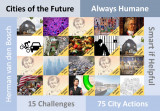
I 'am happy to announce the availability of the English version of my new e-book 'Cities of the Future: Always Humane. Smart if Helpful. You can download it for free. The boek deals with 15 urban challenges like waste, global warming, health, food quality, traffic, housing, living environment, safety, participation, empowerment and resilience. It describes 75 city actions to deal with these challenges.
You will find the English version here: https://www.dropbox.com/s/kfywoszhrn4xi5j/Looking%20for%20the%20city%20of%20the%20future.pdf?dl=1
and the Dutch version here:
https://www.dropbox.com/s/ytdadwgdsdw6zke/Looking%20for%20the%20city%20of%20the%20future%20NL.pdf?dl=1
Helsinki publishes guide to agile urban pilots
How to get the most out of urban experimentation? The guidebook for urban developers sums up learnings and experiences from agile piloting in Helsinki.
The Pocket Book for Agile Piloting shares the experiences from Smart Kalasatama and Jätkäsaari Mobility Lab in Helsinki and condenses the key learnings in a pragmatic and easily digestible way. Free download via Forum Virium
‘DE STAD ALS SPONS’ DOOR INFILTRERENDE BESTRATING

Naast hevige regenval en wateroverlast waar Nederland regelmatig mee te kampen heeft, horen we de laatste zomers steeds meer over problemen met droogte. Hoe gaan we met beide klimaatproblemen om? Onderzoekers van de Hogeschool van Amsterdam (HvA) bieden oplossingen met zogeheten infiltrerende bestrating. Wat doet dat precies? “We willen van de stad een spons maken”, vertelt Ted Veldkamp, onderzoeker en projectleider van onderzoeksproject De infiltrerende stad. Lees meer over de eindresultaten die gemeenten en mkb op weg moeten helpen.
“Infiltrerende bestrating bestaat al tientallen jaren”, vertelt Veldkamp. “Door deze bestrating loopt het regenwater beter weg in de grond. Het water gaat door poreus gemaakte stenen of door de brede voegen die tussen de stenen liggen. Bovendien houdt het systeem dat onder de bestrating wordt aangelegd het water langer vast. Zo voorkom je wateroverlast en kun je water bewaren voor droge periodes.” En dat is nodig met drie opeenvolgende droge zomers en een toename in neerslagintensiteit.
HANDVATTEN VOOR GEMEENTEN EN MKB’ERS
“Objectieve data over de werking en effectiviteit van infiltrerende bestrating was er nog niet”, vervolgt Veldkamp. “Daarom waren gemeenten vaak nog terughoudend. Nu hebben wij deze vorm van bestrating uitvoerig getest op technisch functioneren op de korte en lange duur. Terwijl we de effectiviteit van infiltrerende bestrating meten om gemeenten te overtuigen van de kracht ervan, dragen we met onze inzichten tegelijkertijd bij aan verbeteringen aan de innovaties of producten van mkb'ers. Die data verwerken wij in adviesrapporten met handvatten voor de markt en voor ontwerp, aanleg en beheer en onderhoud.”
PRAKTIJKPROEVEN OPGESCHAALD
Om tot wetenschappelijke data te komen over de waarde van infiltrerende bestrating heeft het team van Veldkamp grootschalig onderzoek gedaan. Zij deden zeventig praktijkproeven door heel Nederland om de infiltratiecapaciteit, de snelheid waarmee water de grond in zakt, te meten. “Daaruit blijkt dat infiltrerende bestrating beter functioneert dan traditionele bestrating”, zegt Veldkamp. “De infiltratiecapaciteit varieert van 220 mm tot 740 mm per uur, ver boven de EU-norm van 200 mm. Piekbuien kun je daarmee goed wegwerken.”
OP JE BEURT WACHTEN
Moeten dan gelijk alle straten in Nederland onder de schop? “Nee, een straat wordt ongeveer elke 15 jaar overhoop gehaald voor onderhoud en aanpassingen”, aldus Kluck. “Beter is rustig je kans af te wachten om de straten klimaatbestendig te maken. Daarnaast hoeft niet iedere straat aangepakt te worden. Je moet bijvoorbeeld goed weten wat de ondergrond en de grondwaterstand is, en hoe hoog de verkeersintensiteit van de straat is. Hoe hoger de intensiteit, hoe sterker de wegfundering moet zijn. Infiltreren kan niet overal. Maar ons streven is wel: onder iedere straat een slootje.”
FOCUS OP DROOGTE
“In het vervolg willen we specifiek kijken naar de ondergrond, de waterbergende weg”, sluit Veldkamp af. “De focus komt te liggen op manieren van opvang, berging en regulering. Doordat we onder elke straat een slootje creëren met innovatieve bergingssystemen, willen we droogte tegengaan. De afgelopen drie zomers waren natuurlijk ongezond, en hebben invloed op landbouw en natuur. Ook dit project gaan we weer in samenwerking doen met gemeenten en mkb’ers. Die praktijkgerichte dynamiek is zeer waardevol gebleken.”
In dit onderzoek werkte de HvA samen met de Hogeschool Rotterdam, de Hanze Hogeschool Groningen en een consortium van de aannemers en mkb-ondernemers die innovatieve infiltrerende producten hebben ontwikkeld.
De week van De infiltrerende stad
Hoe gaan we droogte en wateroverlast tegen? Tijdens De week van De infiltrerende stad van 14 t/m 18 september kom je hier bij de HvA meer over te weten. Van interviews tot praktijkproeven, de hele week staat in teken van infiltrerende bestrating om steden klimaatbestendig te maken.
https://www.hva.nl/urban-technology/gedeelde-content/nieuws/nieuws/2020/09/de-stad-als-spons.html
https://www.hva.nl/urban-technology/subsites/nl/kc-techniek/projecten/projecten-algemeen/infiltrerende-stad.html
How do you experience green spaces in Amsterdam?
Amsterdam needs more houses. The city wants to realise this within the city limits, and that means that the city must become more compact. But what does that mean for your neighbourhood? Won’t that become too crowded? The experience with Corona show that in some places there is now already not enough green space for everyone. How can the city ensure that there is enough green space in the new neighbourhoods to relax, play, sport and meet each other?
We are researching how people experience public space in, and around, those places where the City is planning to build more houses. Will you join us? What do you need green spaces for, and which places are important for you? Go to www.mijnpark.amsterdam for more information or https://app.maptionnaire.com/nl/6768/ to take part immediately.
-------------
Er moeten woningen bijkomen in Amsterdam. De stad wil dit realiseren binnen de stadsgrenzen, en dat betekent dat de stad compacter moet worden. Maar wat betekent dat voor jouw buurt? Wordt het dan niet veel te druk? De ervaringen met Corona laten zien dat er op sommige plekken nu al niet genoeg groene ruimte is voor iedereen. Hoe kan de stad er voor zorgen dat er in die nieuwe stadswijken voldoende groene ruimte is om in te ontspannen, te spelen, te sporten en elkaar te ontmoeten?
Wij doen onderzoek naar hoe mensen de openbare ruimte beleven op, en rondom, die plekken waar de Gemeente van plan is meer huizen te gaan bouwen. Doe jij mee? Waar hebt u groene plekken voor nodig en welke plekken zijn voor u belangrijk? Ga naar www.mijnpark.amsterdam voor meer informatie of https://app.maptionnaire.com/nl/6768/ om direct mee te doen.
LIVECAST: Major cities talk green recovery
Can cities recover from the current crisis and cut emissions at the same time? San Francisco, Vancouver, Copenhagen, Hamburg and Amsterdam share their strategies.
22nd of September, 20.45 – 22.00 hrs
This September Amsterdam was supposed to host the annual meeting of the Carbon Neutral Cities Alliance (CNCA), a network of 22 global cities that have committed to cutting CO2-emissions by at least 80% before 2050. Due to Covid-19 the event has been moved online and focusses on green recovery. How do the cities within the network find and create opportunities in sustainable development to stimulate employment and economic growth?
In this public program Amsterdam alderperson Marieke van Doorninck will speak in our studio with city representatives of San Francisco, Vancouver, Copenhagen and Hamburg and other experts on how their cities are acting and adapting to the crisis. How do they combine greening the economy with other pressing urban needs, like jobs, housing and the struggle against inequality? How does the government support their efforts? And what can they learn from each other?
Register for free and join the conversation.
Contributing speakers:
Marieke van Doorninck
Alderperson Sustainability City of Amsterdam
Johanna Partin
Director Carbon Neutral Cities Alliance
Jørgen Abildgaard
Executive Climate Program Director Copenhagen
George Benson
Climate Change, Economic Development, Inclusion and Equity for the Vancouver Economic Commission
Anselm Sprandel
Head Energy & Climate Hamburg
Timothy Doherty
Policy manager San Francisco Municipal Transport Agency
Bert Tieben
Methodologist SEO Economic Research
Stay up to date
Get notified about new updates, opportunities or events that match your interests.

